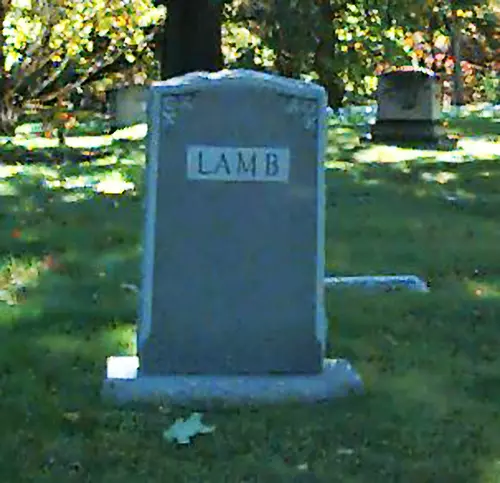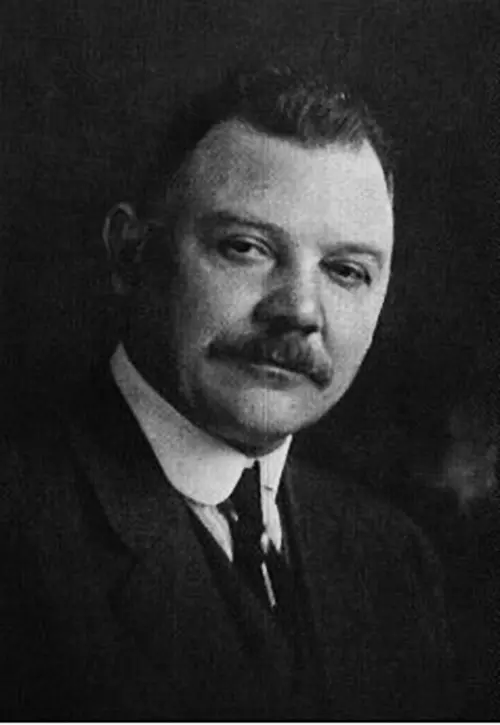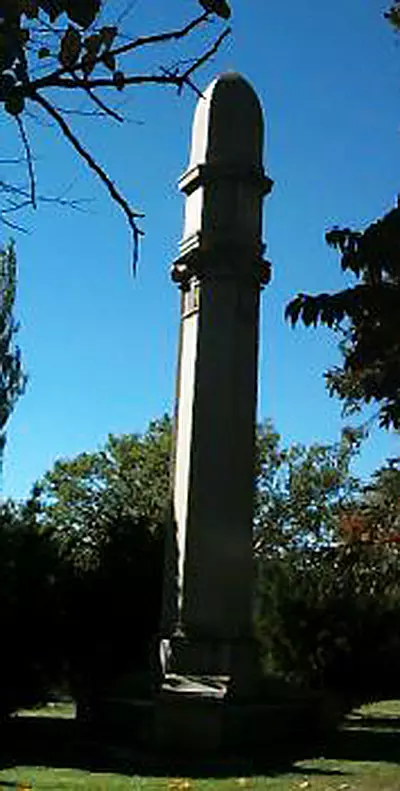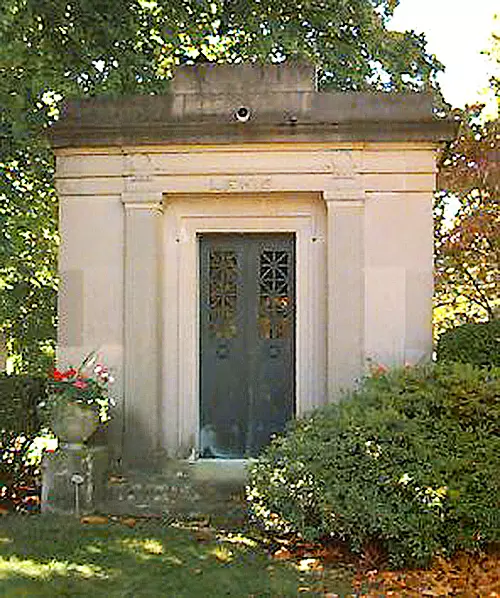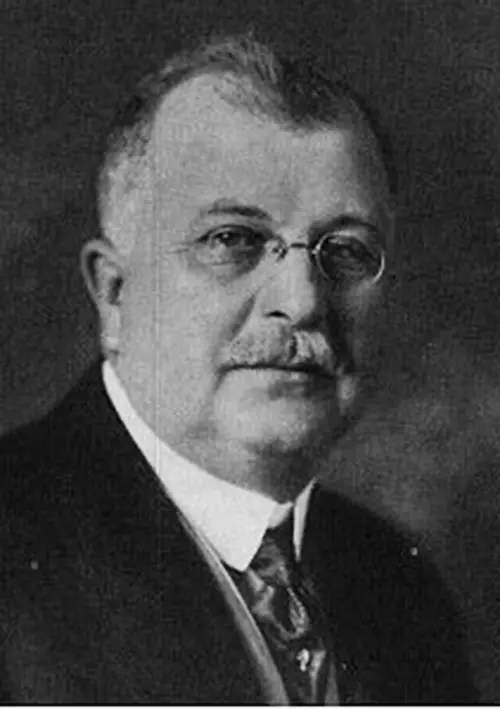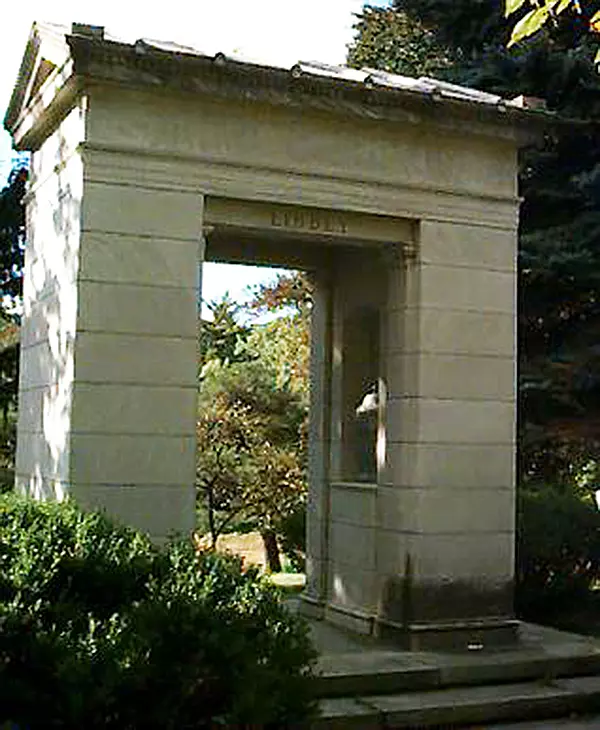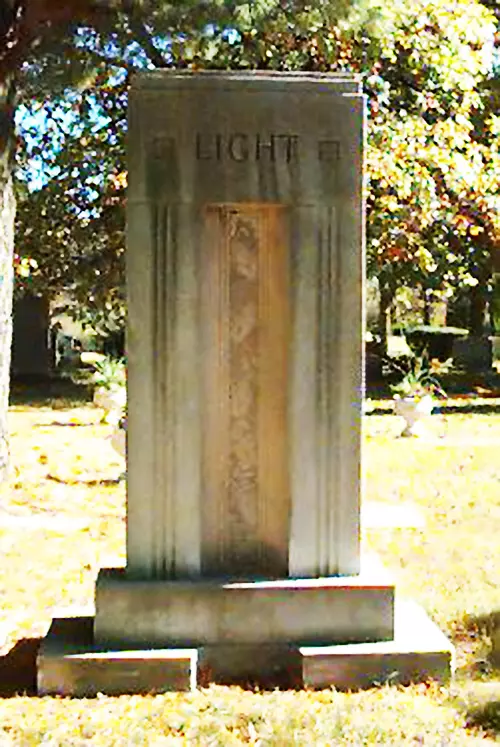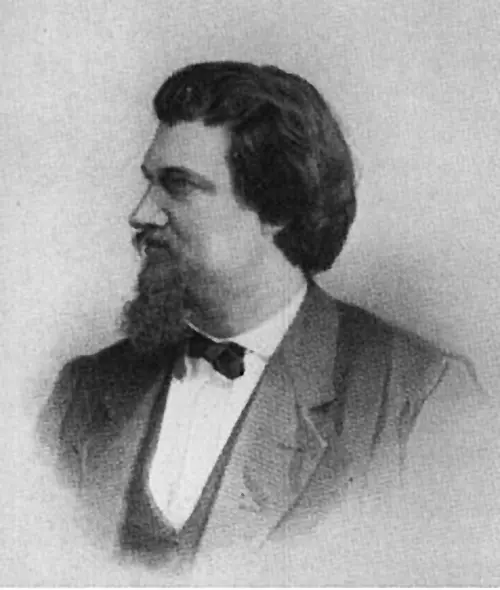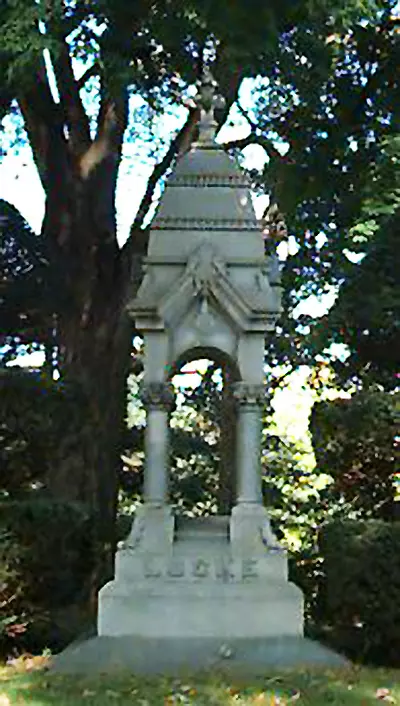Clarence Lamb - George W. Lathrop - Gustav A. Lay - The Charles T. Lewis Family - Edward Drummond Libbey - Gilson Don Light - David Ross Locke - Robinson Locke
Clarence Lamb
Clarence Lamb was born on August 1, 1854, in Hornell, New York. As a young man, Lamb came to Toledo and found work pulling mail boats across the Maumee River. He married Mary Gross in 1881 and they built a home in Toledo. The Lambss later sold that home to invest money in a fish business.
Mr. Lamb founded the Thompson & Lamb Fish Company, a company that proved to be very successful. The business sold its produce in the northeast, central midwest, and southwestern parts of the country. The fish they sold was gathered by their own fleet of gasoline boats.[Killits, John. Toledo and Lucas County, Ohio 1623-1923. vol. 3 (Chicago: S.J. Clarke Publishing Co., 1923), p.181]. The Lambss original investment paid off and they were able to purchase a much larger home on the river.[Toledo Biographical Scrapbook (Krup-Lam). Local History Room. Toledo Lucas County Public Library]. Also the (Toledo Blade, 1 August 1940 and 8 December 1941). The Thompson & Lamb Fish Company served Toledo from its office at Summit and Cherry Streets for over 47 years. The company later became Goulden & Lamb. When Lamb retired, his son, Chester, replaced him.(Toledo Biographical Scrapbook).
After retirement, Clarence Lamb enjoyed watching the work that was carried out on the lake. He kept a close eye on the progress of the engineers and workmen who built the intake of Toledo's lake water supply project. Mr. Lamb had a special interest since the construction site was the original site of one of the first fish camps that he established on Lake Erie's southwestern shores.
On December 8, 1941, after several months of failing health, Clarence Lamb passed away. Surviving Mr. Lamb were his wife, seven of their ten children, sixteen grandchildren, and one great-grandchild.
George W. Lathrop
George W. Lathrop was former Toledo postmaster and Lucas county commissioner. He was born September 9, 1866 on a farm in Richfield Township. When he was four his mother died. He spent the first part his life farming and he attended Sylvania high school. After high school he spent some time at a country school teaching children their A,B,Cs.Minute Biographies: George W. Lathrop, (Toledo Blade, 23 February 1933). He took the civil service examination for a Post Office position after moving to Toledo in 1887. In May 1888 he was appointed a Post Office clerk.(George W. Lathrop Dies In His Sleep Of Heart Disease, Toledo News Bee, 8 September 1936).
George Lathrop worked his way up the ladder at the Post Office becoming a foreman, assistant superintendent and finally a superintendent. In June 1920, President Woodrow Wilson appointed him postmaster. He was highly respected for his work as the president of the Ohio Postmasters Association and vice-president of the National Association of Postmasters.Minute Biographies.
In 1924, George Lathrop quit the Post Office to open a contracting business, George W. Lathrop and Sons.George W. Lathrop Dies In His Sleep... The company built some of Toledos finest homes.Minute Biographies. In 1931, he decided to run for the unexpired term of Lucas County Commissioner. He won and was re-elected two years later for a four year term.Commissioner Lathrop Dies In His Sleep, (Toledo Blade, 8 September 1936). He considered as his biggest problem the relief of the countys unemployed.Minute Biographies. As Commissioner one of Lathrops chief concerns was the construction of the William W. Roche Tuberculosis Sanitarium.George W. Lathrop Dies In His Sleep... He also used his office and his membership in the Rotary Club to promote the interests of crippled children.
George Lathrop joined the Rotary Club in 1920 and he served as a director in 1926. He was also a Mason and member of the Chamber of Commerce and the First Unitarian Church. George and his wife Caroline were the parents of two sons Walter and Albert. He died from a heart attack on September 7, 1932.(Commissioner Lathrop Dies In His Sleep.).
Gustav Lay
Gustav A. Lay embodied the American success story. He immigrated to the United States and became a successful baker, building the United Baking Company which was later sold to the nationally known General Baking Corporation.
Gustav was born in Baden, Germany December 9, 1864 to Christian and Barbara (Hoflin) Lay. His father was engaged in the linen weaving business in Germany. Gustav attended school in Germany until he was eleven years old when he left to become a baker's apprentice.[John M. Killits, ed., Toledo and Lucs County, Ohio 1623-1923, vol. 2 (The S.J. Clarke Publishing Company: Chicago & Toledo, 1923), p.516].
In April 1883, at the age of 17, Gustav came to America. After arriving he went west. The young immigrant arrived in Toledo unable to speak English and with only $1.50 in his pocket. Gustav spent the next three days searching for a job, landing one in a neighborhood bakery at "lower town." He gradually improved his position to that of baker, his specialty was tye bread. Each day after baking he would climb onto his horse-drawn cart to do deliveries around the city.
Gustav decided to set up his own business and in 1888 set up a small bakery on Canton Street.Killits gives Scott Street as the location of the bakery, 516. Shortly after this he married Sophie Sackman and together they built the United Baking Company. The national baking corporation, General Baking, saw the Lay bakery as a rival and began negotiations for its purchase. In 1924 Gustav Lay sold his company for $1,000,000.
Gustav managed the business for General Baking for two years before he decided to retire. In 1926 Sophie died, Gustav spent a number of years traveling with his daughter and granddaughter. He went on two trips around the world and when he was home spent the winters in Florida.
Gustav Lay was a member of many clubs in Toledo. He was also director of the Commercial Savings Bank and Trust Company, the Ohio Citizens Trust Company, and vice president and director of the Toledo Electric Sales Company. Gustav Lay died of a heart attack in 1937 at the age of 72 years.[Toledo Biography Scrapbook, Gustav A. Lay, Local History Room, Toledo-Lucas County Public Library. John M. Killits, ed., Toledo and Lucas County, Ohio 1623-1923, vol.2 (The S.J. Clarke Publishing Company: Chicago & Toledo, 1923), p.519].
Dora Glidden Lewis, Charles Lewis, Howard Lewis, Frank Lewis, William Glidden Lewis
The Lewis Family were successful Toledoans who had various ties to different businesses in Toledo. Dora Glidden Lewis was born June 25, 1855, in Caldwell, Ohio. She came to Toledo when she was twenty-seven years old. Dora was the widow of Charles T. Lewis, the co-founder of the Toledo law firm of Doyle & Lewis. Charles Lewis had been born in 1850. He was well known as a leading Railway attorney of Ohio and was a member of the Toledo Bar for over thirty years. Mr. Lewis also served as president of the Toledo Board of Education and was one of the originators of the Ashland Avenue Baptist Church. He passed away in 1918.(Toledo Blade, 6 September 1938). Mrs. Lewis died December 23, 1937 at the age of 82. She was survived by her sons Howard, Frank, William and Charles T. Lewis, Jr., and a daughter, Mrs. S.O. Richardson, III.(Ibid., 24 December 1937).
Howard Lewis was born in Caldwell, Ohio and moved to Toledo with his parents when he was five. He graduated from Toledo High School and the Doane Academy in Granville, Ohio. In 1900, he graduated from Denison University and in 1903 he graduated from Harvard Law School. That same year, Howard Lewis was admitted to the Ohio Bar and entered private practice with his father's law firm, and later Judge John H. Doyle. In 1910, he became a senior partner at Doyle, Lewis & Warner. He specialized in general corporate practice and was the director of several industrial concerns including the Conklin Pen Company, Fifty Associates Company, and the Toledo Sugar Company. Howard was a member of the American Bar Association for almost fifty years. He was also a member of the Toledo Country Club, the Toledo Club, the Ashland Avenue Baptist Church and the Ohio Society of New York. He was also a member of the boards of Woodlawn Cemetery, Lamson Brothers Company, and Denison University. He died December 10, 1950.(Ibid., 11 December 1950).
Frank Lewis was born June 18, 1879 in Caldwell, Ohio. He attended Toledo Public Schools, Doane Academy, and graduated from Denison University with a bachelor of arts degree in 1902. In 1905, he received his law degree from Harvard Law College and was admitted to the bar the same year. He entered practice with his father following his graduation from Harvard and was admitted to a partnership in his fathers law firm in 1910. Mr. Lewis was a member of Sigma Chi Fraternity, The Toledo Club, The Toledo Country Club, Carranor Hunt and Polo Club, and the Everglades Club in Palm Beach, Florida. He was an attorney for 42 years and was secretary of the Toledo Blade from June 9, 1937 to May 21, 1946. He died May 28, 1947 at the age of 67.(Ibid., 28 May 1947).
William Glidden Lewis managed a Perrysburg farm for 25 years. He attended Ohio State University. His mother, who died about a year prior to William Lewis's death, resided with him. Mr. Lewis never married. He died of a heart attack on February 6, 1939 at the age of 53.(Toledo Times, 7 February 1939).
Charles T. Lewis, Jr. was born in Toledo on July 7, 1892. He graduated from the Lawrenceville school in Lawrenceville, New Jersey in 1912. In 1916 he graduated from Yale University and in 1920 he graduated from Harvard. He was admitted to the bar and joined his father's law firm. He remained in Toledo until 1926 when he went to Columbus as counsel for the New York Central Railroad and moved to the Cleveland office of the railroad. During World War I he served as secretary to Brand Whitlock who was then American Ambassador to Belgium. He died March 1, 1941.(Toledo Blade, 1 March 1941).
Edward Drummond Libbey
Edward Drummond Libbey, son of William L. and Julia M. (Miller) Libbey was born April 17, 1854, in Chelsea, Massachusetts. As a youth he attended public schools in Boston and later enrolled in Boston University. In 1874, Edward's father gave him an interest in his Cambridge, Massachusetts glass business. After the elder Libbey's death in 1883, Edward became owner of the New England Glass Company. High costs for fuel, raw materials and marketing, as well as labor problems, prompted Libbey to look for a new location. The discovery of natural gas in Northwest Ohio, a network of railroad and steamship lines, and local deposits of high quality sandstone made Toledo an ideal site. Libbey responded to advertisements placed by the Toledo Businessmen's Committee in the Boston area newspapers and in 1888 signed a contract to move his company west.[John Killits, Toledo and Lucas County, Ohio, 1623-1923, vol. 3 (Toledo: S.J. Clarke Publishing Co., 1923), p.5, and Tana Mosier Porter, Toledo Profile (Toledo: Toledo Sesquicentennial Commission, 1987), pp.52-53].
In 1888, the business incorporated as the Libbey Glass Company.Killits, vol. 3, 5. Toledo investors helped purchase a four-acre site on Buckeye Street for the factory as well as fifty building lots for glass workers. Libbey's sister, Sarah Miller Libbey (Sally) and Mrs. William S. Walbridge, provided additional funds to move the plant to Toledo.(Toledo Blade, 30 September 1952). The first few years proved difficult and Libbey borrowed heavily to keep the business afloat. But when Michael J. Owens joined the company he developed an automatic bulb making machine that helped Libbey prosper. He also developed machinery to replace the costly hand-blown method of producing glass bottles. Technology and modernization revolutionized the glass business. In 1893, Libbey constructed a glass factory at the Chicago World's Fair where thousands of visitors bought his popular cut-glass products. In addition, glass sheets manufactured in a continuous flow and the 1930s innovation of practical glass threads, known as fiberglass, increased profits for Libbey Glass.[Morgan Barclay and Charles N. Glaab, Toledo: A Gateway to the Great Lakes (Tulsa: Continental Heritage Press, 1982), pp.54-57, and Porter, pp.53-54].
Libbey expanded his business pursuits in 1899 when he helped finance the Owens Bottle Machine Company. Six years later he became president of the Owens European Bottle Machine Company. He organized and served as president of the Libbey-Owens Sheet Glass Company. In 1929 the Owens Bottle Machine Company merged with the Illinois Glass Company to become Owens-Illinois Glass Company. The following year, Libbey-Owens Glass Company combined with the Edward Ford Plate Glass Company to create the Libbey-Owens-Ford Glass Company. The original Libbey Glass Company became a division of Owens-Illinois and Owens-Corning Fiberglas was founded in 1938. Toledo gained the title of "Glass Capital of the World."(Barclay and Glaab, pp.57-59).
Libbey's social interests centered on fine art and on April 18, 1901 he and several associates established the Toledo Museum of Art, the city's main cultural attraction and now one of the finest institutions of its kind in the world. The museum opened in a store room on Madison Avenue and during its early years, Libbey and his wife contributed money, paintings and their prestige to its growth. They donated land at Monroe Street and Scottwood where a new museum building opened in 1912. Among its many public programs, the museum emphasized art education and music study for the masses.[John Killits, Toledo and Lucas County, Ohio, 1623-1923, vol. 1 (Toledo: S.J. Publishing Company, 1923), p.517 and Porter, p.78]. Libbey acted as museum president and continued to aid the institution financially. He also organized an art society in Toledo. In his will, Libbey provided two million dollars to construct a school of design and a concert hall, additions to the museum. His wife initiated the project in 1930, which helped to employ approximately 2,500 men during the early years of the Great Depression. The Peristyle opened on January 10, 1933 with a concert by the Philadelphia Symphony orchestra.(Toledo Blade, 13 November 1925 and Porter, p.64 and Porter, pp.84-86).
Libbey participated in other Toledo activities. He owned large tracts of local real estate, notably the Adams Street property. Edward Drummond Libbey high school opened in the south end of the city in 1923. Libbey gained an international reputation for his artistic appreciation and promotion of education. On July 26, 1922, King Albert of Belgium conferred upon Libbey the Belgian Order of the Crown with the rank of Commander in recognition of his accomplishments.(Killits, vol. 3, p.7).
Edward Drummond Libbey died of pneumonia in November 1925 at the age of 72. His wife, Florence Scott Libbey, passed away on March 12, 1952. Edward Drummond Libbey's corporations and interests in Toledo are the reason that this area is still called the "Glass City" today.(Toledo Blade, 13 November 1925). Edward Drummond and Florence Scott Libbey are buried in a mausoleum in Woodlawn Historic Cemetery, Lot 68.
Gilson D. Light
Gilson Don Light was born in Columbus Grove, Ohio, in 1883. He began his career in business but is known for his work as the Safety Director of Toledo from 1922-1924. He also served for a short time as the Warden of the Ohio Penitentiary. Moreover, he was a National Guardsman for forty years and rose in rank from private in the Ohio National Guard to Adjutant General. In the federal service, he went from a private to the rank of Lieutenant Colonel.["Gilson D. Light", The Historical Society of Northwestern Ohio. Vol 3, No. 2 (April 1941), p.12].
When the call for national service came in 1917, Light resigned his Ohio command and enlisted as a private in the 1st Infantry Brigade. He was discharged and commissioned as a Major in the Brigade thirteen days later. The Brigade was redesignated the 74th Infantry under his command. Light's first engagement was in the Baccarat sector near Lunneville, France, and he was soon promoted to Lieutenant Colonel. He was in the drive on Brussels when the armistice was signed. Light was honored with the French and Belgian Croix de Guerre and the United States Order of the Purple Heart.(Ibid).
When Light returned to Ohio, he was reappointed to command an Ohio National Guard regiment. He became adjutant of the 37th division of the National Guard until the division was inducted into federal service. He then became State Selective Service Director.(Toledo Blade, 3 March 1941). He would have entered the Federal military service again if he had not been rejected because of a physical defect that was the result of his long service.("Gilson D. Light," p.12). At the time of his death on February 21, 1941, he was Adjutant General of Ohio.
Light was buried with full military honors. Nearly 1,000 people attended the service and a crowd of several hundred persons gathered for the final rites at Woodlawn Cemetery. The procession was escorted by motorized Army equipment. The body was carried to the grave through a guard of representatives from the American Legion, Veterans of Foreign Wars, and Spanish-American War. The Service Troop (Toledo) and Troop D (Cleveland) offered the military honors and an eight soldier squad fired the three-volley salute, followed by taps. The American flag which had draped the casket was given to Mrs. Light at the close of the service.(Toledo Blade).
The Ohio National Guard Armory on Tracy Road was dedicated in honor of Major General Gilson D. Light whose military career dated from 1899. This complex, built on a fifteen acre site, houses five guard units from Lucas and Wood counties. This $2.5 million armory, which has been occupied since September of 1975, when it replaced the former Wall Street Armory in Toledo.(Ibid).
David Ross Locke
David Ross Locke was born in Vestal, New York, September 20, 1833. He grew up in poverty and had little chance to gain a formal education. He struggled till he was thirty to support his family, working in the newspaper business.[John Killits, Toledo and Lucas, Ohio, 1623-1923, vol. 2 (Toledo: S.J. Clarke Publishing Company, 1923): p.491]. Locke was a traveling printer and editor who operated newspapers in Plymouth, Mansfield, Bucyrus, and Findlay. While at Findlay, Ohio, he started writing the Nasby letters.[History of the Blade. (The Blade: A booklet distributed that gives a chronological history of the newspaper.)] The first one was printed on March 21, 1861 in the Findlay Jeffersonian. These letters were political satirical jabs at the pro-Southern sentiment in the North.[Morgan Barclay and Charles N. Glaab, Toledo: Gateway to the Great Lakes (Tulsa: Continental Heritage Press, Inc., 1982): p.87].
The attention Locke gained from the Nasby Letters landed him a position working for the Toledo Blade. In 1876 he purchased a controlling interest and became president of this Northwest Ohio newspaper. He was an editor, writer and publicist. The Toledo Blade became financially sound under this new management. Locke built up the weekly edition by adding sections for farmers, young people, and women, as well as poetry and fiction sections. He established a Veterans of the Union Army column so people could locate former comrades and made the weekly paper a review of current news in the world.(History of the Blade). Lockes Weekly Blade became one of the nation's most influential publications, especially in small towns and rural areas. Besides The Blade, the company published Lockes Monthly and the American Farm Journal.(Killits, p.483).
Locke is most known for the fictional name and character he created and wrote under, "Petroleum Vesuvius Nasby". Nasby, a character that one could describe as an ignorant bigot, represented everything David Locke was against. Locke, a reformist, fought for the rights of women, African-Americans, and labor. He represented these ideals through Nasby which he "effectively used to satirize racial prejudice and corruption during and after the Civil War."(Barclay and Glaab, p.86).
It was these Nasby letters that enabled Locke to influence the people of the North from 1850 until the close of the Civil War. Through his satirical writings, he became a factor in shaping opinions during this because of the wide circulation of the Weekly Blade. Each paper was believed to have been examined by three to five persons, and it is estimated that the Weekly Blade served almost a million Americans. Circulation grew quickly. In 1868 12,000 copies were sold. This soared to 200,000 in 1884.(History of the Blade).
President Lincoln particularly appreciated these letters that he thought "stirred people to right thinking and decisive action."(Killits, p.491). Lincoln declared that Mr. Locke's letters did much to solidify Union sentiment during the war and sent a letter to Locke thanking him for his services. Locke was offered political appointments by both Lincoln and Grant, but he declined.(History of the Blade).
David Locke helped the Toledo Blade to become a nationally known publication. Under his effective editorial guidance, the weekly edition of the Blade was read by Americans from coast to coast and was a precursor of the national weekly news magazine. For the next twenty years, he built himself a reputation as a leading newsman, and a large personal fortune as well. He was a nationally recognized and popular public lecturer.(Ibid).
The last letter of Petroleum V. Nasby was dated December 26, 1887.Barclay and Glaab, 87. Upon the death of David Ross Locke in 1888 Robinson Locke, David Locke's son, took charge of the Blade. He held this office for about twenty-five years, devoted more attention to the daily edition of the Blade which made it a distinguished paper in Toledo and the surrounding area. The Weekly Blade was discontinued on October 9, 1924.(History of the Blade).
Robinson Locke
Robinson Locke was born in Plymouth, Ohio, March 15, 1856. Robinsons father, David Ross Locke, was the nationally known writer who wrote under the name of Petroleum V. Nasby. Robinson worked for his father as a reporter at the Blade, and in 1888, upon the death of his father, Robinson Locke took charge of the newspaper. He found that the weekly edition of the Blade had a wide national circulation, but the daily edition of the Blade only had influence in the community it served. When he became president of the company and editor of the paper, Locke sought to reverse this order. Throughout the years the daily edition prospered and its scope of influence gradually increased.(The Toledo Blade, 22 June 1936).
Robinson Locke was able to become a successful newspaper owner as he knew the fundamentals of the work. His father gave ideas and policies which had been broadened by their extensive travels together. When Robinson, also known as Bob by his close friends, accompanied his father to Europe early in 1881, he aided him in writing the "Nasby in Exile" articles.(Ibid).
In the fall of 1881 Robinson returned to Europe to study German, French, and music. He and his father again toured the continent together. Robinson Locke wrote extensively on his travels. His work, "Days and Nights in Old Japan," was among his most regarded efforts and appeared in the Blade.(Ibid).
Locke came home in 1883. Shortly after his arrival, he received an appointment as United States consul to Newcastle-on-Tyne by President Arthur. This position was terminated in 1885 when President Cleveland assumed office.(Ibid).
Locke was always interested in theater and was a close student of ancient and modern drama. For twenty-five years he wrote pieces concerning the stage and actors. His critiques, which appeared in the Blade, were influential. His fluent writing style appealed to the casual reader as well as the thoughtful student.(Ibid., 21 April 1920).
In addition, he owned a biographical library of actors and actresses from America and England. In fact, his walls in the old Blade building on Jefferson Avenue and Superior Street were covered with autographed portraits of them. He assembled a collection of theatrical materials with every prominent member of the profession, and each of these people had from one to eight bound volumes. This great collection was bequeathed by Mr. Locke to the New York Public Library where it is now made accessible.(Ibid., 22 June 1936).
On July 15, 1886, Robinson Locke married Kate King of Toledo. She died eight years later on January 6, 1894.(Ibid., 21 April 1920). In 1909 Robinson Locke married Mabel Dunham. She was born in Boston and moved to Toledo after they married. She lived here until she moved back to New York in 1924. As Mabel Dixey, Mrs. Locke had a brief career as an actress before her marriage. She passed away in February, 1968.(Ibid., 12 February 1968).
Robinson Locke, an active leader in civic affairs in Toledo, died April 20, 1920. Not only was he one of the early benefactors of the Toledo Public Library and a member of the school board, he was one of the incorporators of the Toledo Museum of Art. Locke was the first vice-president of the board of trustees of this institution from 1901 to 1911. Furthermore, he was one of the founders of the Civic Music League, a member of the National Geographical Society and played a role in founding the Northwestern Ohio Historical Society in which he was a member.(Ibid., 21 April 1920).

